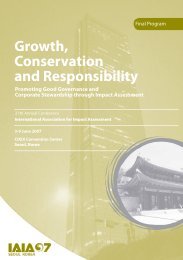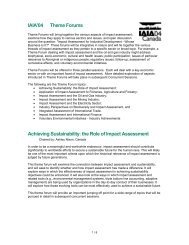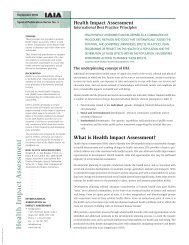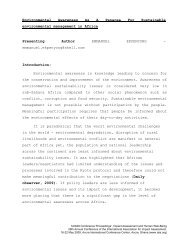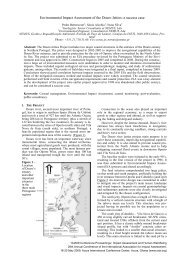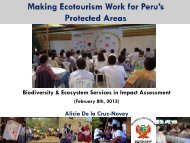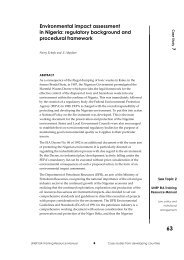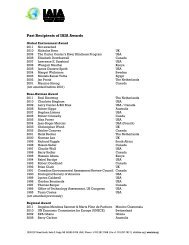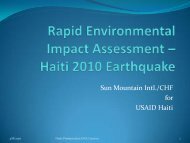Power, poverty and sustainability - International Association for ...
Power, poverty and sustainability - International Association for ...
Power, poverty and sustainability - International Association for ...
Create successful ePaper yourself
Turn your PDF publications into a flip-book with our unique Google optimized e-Paper software.
• IAIA06 Abstracts Volume •<br />
CS 9.1 TOOL DEVELOPMENT<br />
Integrated Assessment <strong>and</strong> Plannning or Strategies<br />
<strong>for</strong> Sustainable Development?<br />
Cherp, Aleh; Lund University & Central European University,<br />
Nador u. 9, Budapest, 1051 Hungary. +46462220280.<br />
cherpa@ceu.hu<br />
Integrated assessment seeks to facilitate sustainable<br />
development through making planning processes more<br />
in<strong>for</strong>med, transparent <strong>and</strong> integrated. When applied to<br />
national <strong>and</strong> regional (sustainable) development strategies,<br />
this approach has significant potential, but also faces certain<br />
limitations.<br />
Comparing the premises of the integrated assessment with<br />
strategy <strong>for</strong>mation theories one can identify the types of<br />
analysis <strong>and</strong> communication which are often neglected in<br />
such assessments, but which can significantly enhance its<br />
influence on development programmes.<br />
This point will be illustrated by lessons from specific<br />
applications of integrated assessment such as in case of<br />
Tomsk Regional Socio-Economic Development Strategy <strong>and</strong><br />
other sustainable development strategies.<br />
Integrating IA Guidelines <strong>for</strong> the Oman Oil <strong>and</strong> Gas<br />
Sector: A Best Practice Process Based on Multi<br />
Stakeholder Consultation<br />
LaPin, Deirdre; Consultant (<strong>for</strong>merly Shell <strong>International</strong>), 3732<br />
Veazey Street, NW, Washington, DC 20016 USA. 202-537-<br />
7274. Fax 202-537-4887. dlapin@verizon.net<br />
Petroleum Development Oman, operated by Shell, sought to<br />
revise its IA guidelines to fully integrate analysis <strong>and</strong><br />
management of environment, health, <strong>and</strong> social impacts. Key<br />
aims were to increase IA efficiency <strong>and</strong> value to business,<br />
reduce cost, improve prediction, achieve more effective<br />
mitigations, <strong>and</strong> exploit opportunities <strong>for</strong> reducing <strong>poverty</strong><br />
through targeted social investment. Success required the input<br />
<strong>and</strong> support of government regulators, operations units, other<br />
oil <strong>and</strong> gas producers, HSE experts, Shell advisors, local IA<br />
contractors, civil society, <strong>and</strong> communities.<br />
A five-step process ensured continuous stakeholder<br />
participation. A “pilot” IA was selected, in this case,<br />
evaluating a 300 km loop extension of an existing gas<br />
pipeline. Choosing a project “addition” implicitly compared<br />
the “old” approach of conducting separate IAs–in which many<br />
impacts were not <strong>for</strong>eseen–with the “new” IA stressing<br />
integration <strong>and</strong> community engagement. Five steps in the total<br />
process were: (1) holding a broad stakeholder workshop<br />
yielding input <strong>and</strong> advice; (2) revising <strong>and</strong> integrating new IA<br />
guidelines; (3) testing the guidelines in the gas pipeline “pilot”<br />
IA <strong>and</strong> consulting local stakeholders; (4) convening a second<br />
stakeholder workshop to review the “pilot” experience <strong>and</strong><br />
solicit further advice; (5) revision <strong>and</strong> final drafting of<br />
integrated IA guidelines <strong>and</strong> methodology.<br />
The Contribution of Environmental Assessment to<br />
Sustainable Development: Towards a Richer<br />
Empirical Underst<strong>and</strong>ing<br />
Cashmore, Matthew; University of East Anglia, School of<br />
Environmental Sciences, University of East Anglia, Norwich,<br />
Norfolk NR4 7TJ UK. +441603 593797. Fax +441603 591327.<br />
m.cashmore@uea.ac.uk www.uea.ac.uk<br />
Bond, Alan; University of East Anglia.<br />
Cobb, Dick; University of East Anglia.<br />
This paper advances theory on the <strong>sustainability</strong> potentialities<br />
of environmental assessment based on an empirical<br />
investigation of its outcomes in three case studies. The<br />
findings demonstrate that conventional theory<br />
substantially underestimates the multiplicity of<br />
mechanisms by which environmental assessment<br />
contributes to sustainable development. The authors<br />
propose an integrative conceptualisation of<br />
environmental assessment’s <strong>sustainability</strong> potentialities<br />
comprised of four principal categories: learning,<br />
governance <strong>and</strong> development outcomes, <strong>and</strong> attitudinal<br />
<strong>and</strong> value changes. It is concluded that, despite being<br />
essentially exploratory, the research has far-reaching<br />
implications, <strong>for</strong> it implies a radical re<strong>for</strong>mulation of<br />
environmental assessment theory is required.<br />
Soils <strong>and</strong> SEA<br />
Askew, Rob; EDAFOS, The Old Stables, Up Exe, Exeter,<br />
Devon EX5 5ND Engl<strong>and</strong>. 01392 861043. Fax 01392 833<br />
683. robaskew@edafos.co.uk www.edafos.co.uk<br />
Curran, Jo; Environ, Swallow Court, Devonshire Gate,<br />
Tiverton, Devon EX16 7EJ Engl<strong>and</strong>. 01884 842010. Fax<br />
01884 842011. jcurran@uk.environcorp.com<br />
www.environcorp.com<br />
James, Emma; Environ, Swallow Court, Devonshire<br />
Gate, Tiverton, Devon EX16 7EJ Engl<strong>and</strong>. 01884 842010.<br />
Fax 01884 842011. ejames@uk.environcorp.com<br />
www.environcorp.com<br />
Soil is a subject which is often overlooked in SEA despite<br />
its being mentioned within the SEA Directive. UK<br />
planners produce a number of plans which impact on<br />
soil in a number of ways through l<strong>and</strong> take <strong>and</strong> direct<br />
soil loss, leaching <strong>and</strong> changes to structure <strong>and</strong> erosion<br />
patterns. These plans include Transport, Waste <strong>and</strong><br />
Minerals plans which set the framework <strong>for</strong> such<br />
projects as new roads, quarries <strong>and</strong> l<strong>and</strong>fill sites which<br />
can involve the loss of large areas of topsoil. Despite<br />
this, there is little guidance on how to address soil issues<br />
in SEA.<br />
The paper will review UK SEAs <strong>for</strong> their coverage of soil<br />
issues through SEA stages including collection of soil<br />
baseline data, review of relevant plans which set out soil<br />
protection policies/objectives, selection of soil SEA<br />
objectives <strong>and</strong> indicators, impact assessment, mitigation<br />
<strong>and</strong> monitoring. This review will seek to answer such<br />
questions as:<br />
• Do any types of plan/stages of SEA address soil<br />
issues more comprehensively?<br />
• What linkages are made between soil <strong>and</strong> other<br />
issues?<br />
The paper will then conclude with an analysis of how<br />
soil issues could be better integrated into SEA <strong>and</strong> make<br />
suggestions on what guidance is needed.<br />
CS 10.1 EIA AND AGRICULTURE<br />
Impact Assessment of Natural Resources<br />
Management Technologies in Crop-Livestock<br />
Systems in Arid <strong>and</strong> Semi-arid Areas<br />
Laamari, Abdelali; National Institute <strong>for</strong> Agricultural<br />
Research, Dryl<strong>and</strong> Research Center, Po.Box. 589, Settat,<br />
Settat 26000 Morocco. 212.23.72.93.00. Fax<br />
212.23.72.93.06. al.laamari@menara.ma<br />
www.inra.org.ma<br />
Barley-livestock farming system (barley/fallow or<br />
continuous barley) is typical in dry areas of WANA<br />
region. This has resulted in degradation of natural<br />
resources <strong>and</strong> decreased productivity, which in turn has<br />
46


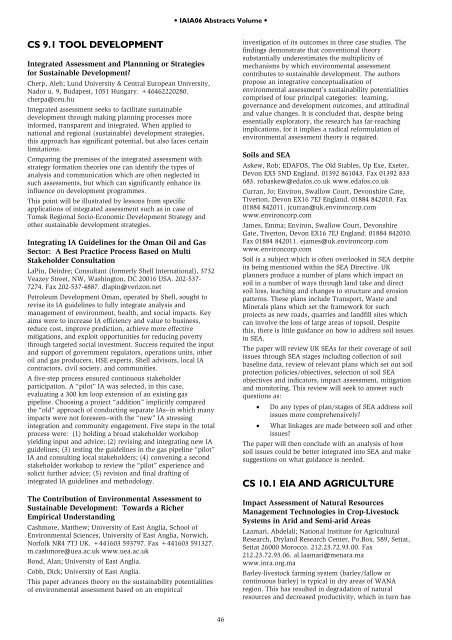

![Session Report [PDF] - International Association for Impact Assessment](https://img.yumpu.com/22416146/1/190x245/session-report-pdf-international-association-for-impact-assessment.jpg?quality=85)
![Session Report [PDF] - International Association for Impact Assessment](https://img.yumpu.com/22416140/1/184x260/session-report-pdf-international-association-for-impact-assessment.jpg?quality=85)
